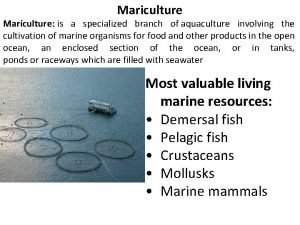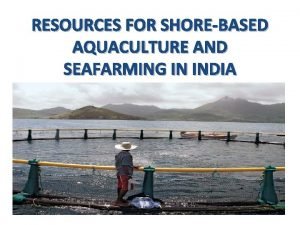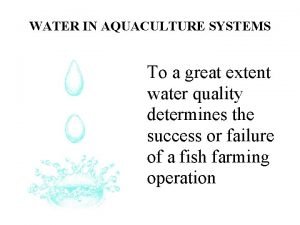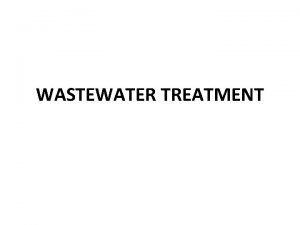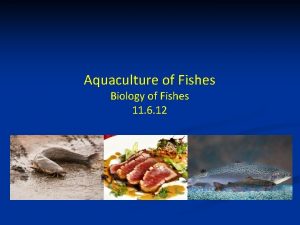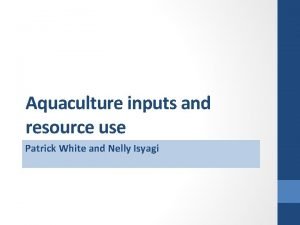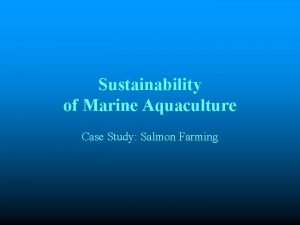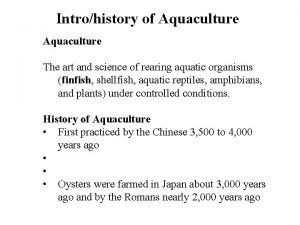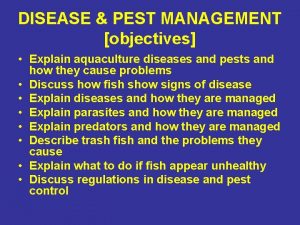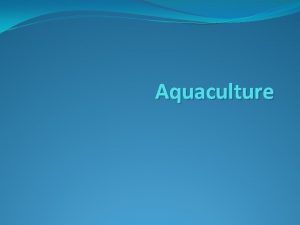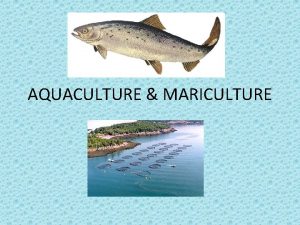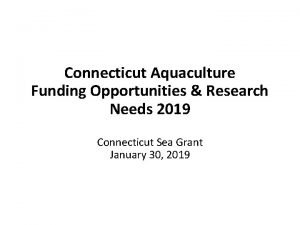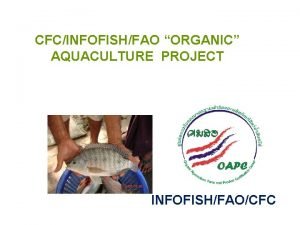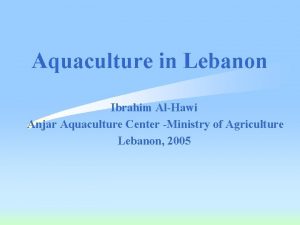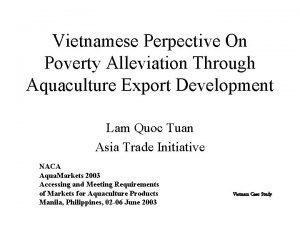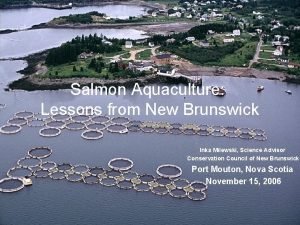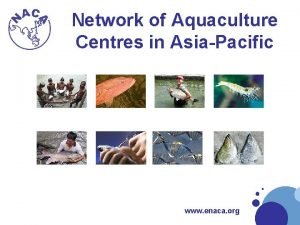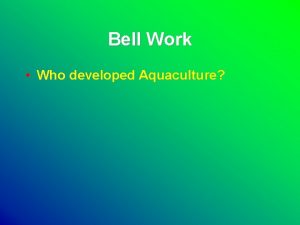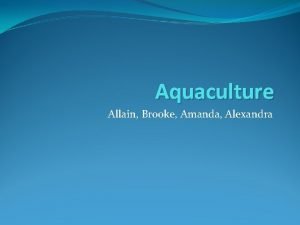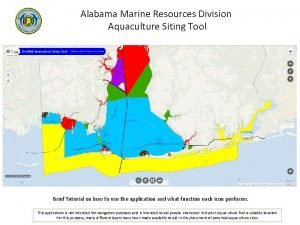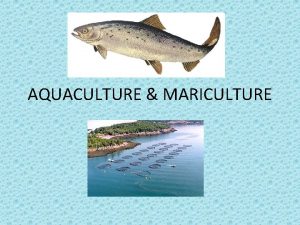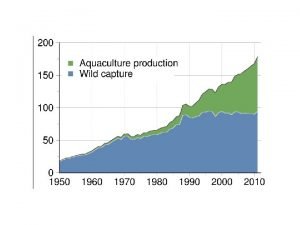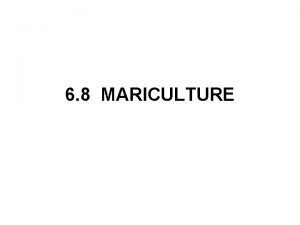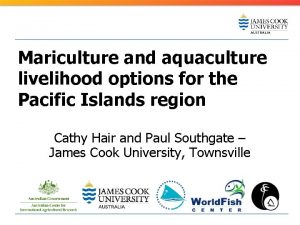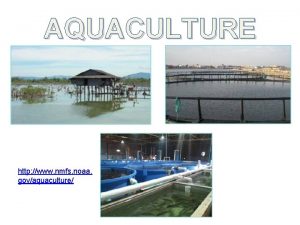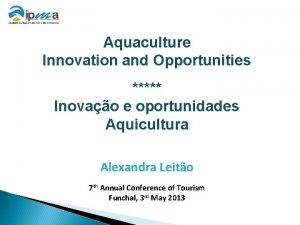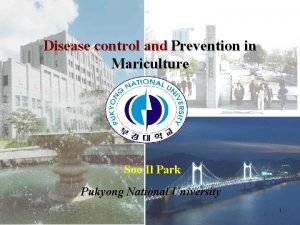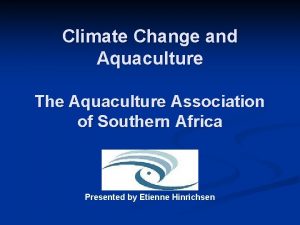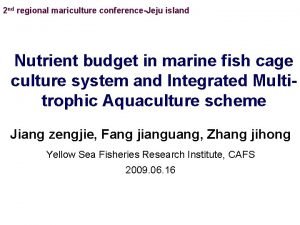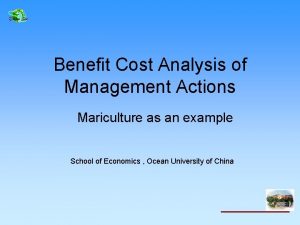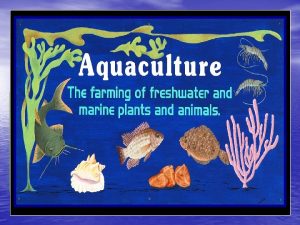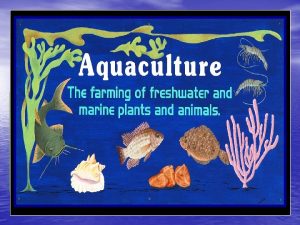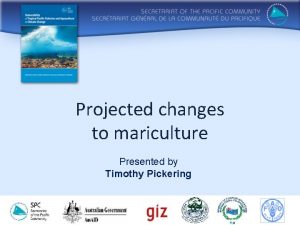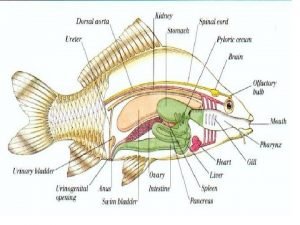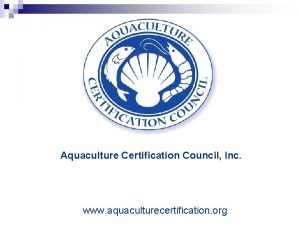Mariculture and Aquaculture Aquaculture is the application of






































- Slides: 38


Mariculture and Aquaculture • Aquaculture is the application of farming techniques to the growth and harvesting of aquatic organisms • The term mariculture applies specifically to marine organisms • The column of marine organisms produced through mariculture has risen three-fold since 1990 • As an example, farmed fish account for 25% of shrimp consumed each year • Other “farmed” species include milkfish, molluscs, seaweed, salmon and Pacific threadfish • 개방해산양식 (open mariculture); 반개방양식 (semiculture); 폐쇄식 (Closed); 집약식 (intensive mariculture); 바 다목장 (ranching) 2

Figure 17. 14

Figure 17. 15

Commercial Mariculture Species 5

Problems Associated with Aquaculture/Mariculture • Disease and parasites can be high due to many organisms in close proximity 질병과 기생충 • Different food requirements may be present at different life stages 사료 • Species that require open water cannot be raised this way 외 양성 어종 • Maintaining water quality may be difficult 수질 환경 유지 • If farmed species escape, they may breed with wild stocks and dilute genome of wild population 양식종 야생종 유전정보 • Pollution from farm ponds can leak into nearby waters 자가오 염 • In some areas of the world, mangroves and other estuarine communities are destroyed to create farm ponds 서식처 파괴 6



http: //www. docstoc. com/docs/128289747/Cons-of-Aquaculture


http: //www. dommrc. com/images/page-images/diagram-idreem. png

http: //www. dfo-mpo. gc. ca/aquaculture/sci-res/imta-amti/images/imta-amti-007 -large. jpg

http: //www. miseagrant. umich. edu/explore/fisheries/what-is-aquaculture/aquaculture-mi-diagram-750 w/

http: //pwsac. com/wpcontent/uploads/2013/03/Lifecycle 2. jpg

Figure 17. 16

Figure 17. 17

Marine Life as Items of Commerce and Recreation • 상업과 레크리에이션 대상 • Other items harvested for reasons other than direct consumption: – Mangroves – for timber and charcoal – Pearls, shells, coral and sea turtle shells for jewelry – Some species harvested for their chemical compounds that are used as “marine natural products” 해양자연 생산물 – 해조류(식량, 식품 가공, 플라스틱 등) 17

Marine Life as Items of Commerce and Recreation • 해양레크리에이션 (바다와 레크리에이션) • Amateur anglers – in general, marine resources caught by recreational anglers is only about 30% of the amount caught by commercial fishermen • However, for some species, the number of individuals caught each year may be solely from recreational anglers • Other species are harvested each year for the aquarium trade 수족관 사업 18

Non-Living Resources Harvested from the Marine Environment • Oil and Gas 석유와 개스 – 플랫폼, 해양플랜트 – 메탄(methane); 메탄하이그레 이트(methane hydrate, clathratres) – 세일가스 – 프랙킹 • Sand gravel for the construction industry 사력 • Freshwater via desalination process 담수화 19

Figure 17. 18 20


Page 393 Bottom

Page 393 Top


Desalination Technologies • Reverse Osmosis (RO) 역삼투법 • Distillation 증발법 – multistage flash (MSF) 플래시증류법 – multiple effect distillation (MED) 다중효용증발 법 – vapor compression distillation (VC) 증기압축 법



Non-Living Resources Harvested from the Marine Environment • Na. Cl – 염전 • Polymetallic nodules – contain manganese, nickel, copper and cobalt • 28


Non-Living Resources Harvested from the Marine Environment • Tidal energy 30



Figure 17. 20

Ocean Thermal Energy Conversion • Ocean Thermal Energy Conversion (OTEC) utilises the temperature difference between the warm surface sea water and cold deep ocean water to generate electricity. For OTEC to produce a net output of energy, the temperature difference between the surface water and water at a depth of 1000 m needs to be about 20 o. C (figure 1).


Ocean Thermal Energy Conversion

Ocean Thermal Energy Conversion

Page 401
 Mariculture is
Mariculture is Sea farming in india
Sea farming in india Recirculating aquaculture system
Recirculating aquaculture system Aquaculture water treataent factory
Aquaculture water treataent factory Raceways aquaculture
Raceways aquaculture Example of aquaculture
Example of aquaculture Process of aquaculture
Process of aquaculture Aquaculture case study
Aquaculture case study Akuakultur berasal dari bahasa
Akuakultur berasal dari bahasa Aquaculture purpose
Aquaculture purpose Aquaculture pest analysis
Aquaculture pest analysis What are the objectives of aquaculture
What are the objectives of aquaculture Aquaculture refers to
Aquaculture refers to Objectives of aquaculture
Objectives of aquaculture Aquaculture funding opportunities
Aquaculture funding opportunities Europe organic aquaculture market
Europe organic aquaculture market Aquaculture in lebanon
Aquaculture in lebanon Scope of aquaculture
Scope of aquaculture Aquaculture doha
Aquaculture doha New brunswick aquaculture
New brunswick aquaculture Enaca
Enaca Bell aquaculture
Bell aquaculture Amanda alexandra
Amanda alexandra Alabama marine resources division
Alabama marine resources division Hát kết hợp bộ gõ cơ thể
Hát kết hợp bộ gõ cơ thể Bổ thể
Bổ thể Tỉ lệ cơ thể trẻ em
Tỉ lệ cơ thể trẻ em Gấu đi như thế nào
Gấu đi như thế nào Chụp phim tư thế worms-breton
Chụp phim tư thế worms-breton Chúa yêu trần thế
Chúa yêu trần thế Các môn thể thao bắt đầu bằng tiếng chạy
Các môn thể thao bắt đầu bằng tiếng chạy Thế nào là hệ số cao nhất
Thế nào là hệ số cao nhất Các châu lục và đại dương trên thế giới
Các châu lục và đại dương trên thế giới Công thức tính độ biến thiên đông lượng
Công thức tính độ biến thiên đông lượng Trời xanh đây là của chúng ta thể thơ
Trời xanh đây là của chúng ta thể thơ Mật thư tọa độ 5x5
Mật thư tọa độ 5x5 101012 bằng
101012 bằng độ dài liên kết
độ dài liên kết
